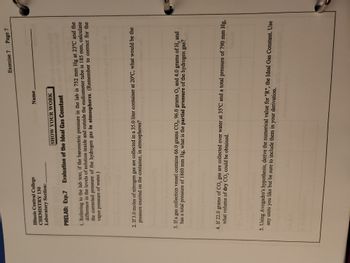on: SHOW YOUR WORK PRELAB: Exp.7 Evaluation of the Ideal Gas Constant 1. Referring to the lab text, if the barometric pressure in the lab is 752 mm Hg at 23°C and the difference in the levels of solution inside and outside the eudiometer tube is 185 mm, calculate the corrected pressure of the hydrogen gas in atmospheres. (Remember to correct for the vapor pressure of water.) 2. If 3.0 moles of nitrogen gas are collected in a 35.0 liter container at 20°C, what would be the pressure exerted on the container, in atmospheres? 3. If a gas collection vessel contains 66.0 grams CO,, 96.0 grams O, and 4.0 grams of H, and has a total pressure of 1860 mm Hg, what is the partial pressure of the hydrogen gas?
on: SHOW YOUR WORK PRELAB: Exp.7 Evaluation of the Ideal Gas Constant 1. Referring to the lab text, if the barometric pressure in the lab is 752 mm Hg at 23°C and the difference in the levels of solution inside and outside the eudiometer tube is 185 mm, calculate the corrected pressure of the hydrogen gas in atmospheres. (Remember to correct for the vapor pressure of water.) 2. If 3.0 moles of nitrogen gas are collected in a 35.0 liter container at 20°C, what would be the pressure exerted on the container, in atmospheres? 3. If a gas collection vessel contains 66.0 grams CO,, 96.0 grams O, and 4.0 grams of H, and has a total pressure of 1860 mm Hg, what is the partial pressure of the hydrogen gas?
Chemistry
10th Edition
ISBN:9781305957404
Author:Steven S. Zumdahl, Susan A. Zumdahl, Donald J. DeCoste
Publisher:Steven S. Zumdahl, Susan A. Zumdahl, Donald J. DeCoste
Chapter1: Chemical Foundations
Section: Chapter Questions
Problem 1RQ: Define and explain the differences between the following terms. a. law and theory b. theory and...
Related questions
Question
100%
#1

Transcribed Image Text:on:
SHOW YOUR WORK
PRELAB: Exp.7 Evaluation of the Ideal Gas Constant
1. Referring to the lab text, if the barometric pressure in the lab is 752 mm Hg at 23°C and the
difference in the levels of solution inside and outside the eudiometer tube is 185 mm, calculate
the corrected pressure of the hydrogen gas in atmospheres. (Remember to correct for the
vapor pressure of water.)
2. If 3.0 moles of nitrogen gas are collected in a 35.0 liter container at 20°C, what would be the
pressure exerted on the container, in atmospheres?
3. If a gas collection vessel contains 66.0 grams CO,, 96.0 grams O, and 4.0 grams of H, and
has a total pressure of 1860 mm Hg, what is the partial pressure of the hydrogen gas?
Expert Solution
This question has been solved!
Explore an expertly crafted, step-by-step solution for a thorough understanding of key concepts.
This is a popular solution!
Trending now
This is a popular solution!
Step by step
Solved in 3 steps with 3 images

Follow-up Questions
Read through expert solutions to related follow-up questions below.
Follow-up Question
#2

Transcribed Image Text:### Evaluation of the Ideal Gas Constant
**Instructions: SHOW YOUR WORK**
#### Illinois Central College
**CHEMISTRY 130 - Laboratory Section:**
---
#### Exercise 7 - Page 7
1. Referring to the lab, if the barometric pressure in the lab is 752 mm Hg at 23°C and the levels of H₂ (gas) inside and outside the eudiometer tube is 185 mm, calculate the corrected pressure of the hydrogen gas in **atmospheres**. (Remember to correct for the vapor pressure of water.)
2. If 3.0 moles of nitrogen gas are collected in a 25.0-liter container at 20°C, what would be the pressure exerted in the container, in atmospheres?
3. If a gas collection consists of 1.0 grams of CO₂, 6.0 grams O₂, and 4.0 grams of H₂, and has a total pressure of 600 mm Hg, what is the partial pressure of the hydrogen gas?
4. If 22.0 grams of CO₂ gas are collected over water at 35°C and a total pressure of 790 mm Hg, what volume of dry CO₂ could be obtained?
5. Using Avogadro’s hypothesis, derive the numerical value for “R,” the Ideal Gas Constant. Use any units you like but be sure to include them in your derivation.
---
This exercise aims to help students understand the application of the Ideal Gas Law in different scenarios, ensuring they can accurately determine the necessary variables and perform the correct calculations using given conditions.
Solution
Knowledge Booster
Learn more about
Need a deep-dive on the concept behind this application? Look no further. Learn more about this topic, chemistry and related others by exploring similar questions and additional content below.Recommended textbooks for you

Chemistry
Chemistry
ISBN:
9781305957404
Author:
Steven S. Zumdahl, Susan A. Zumdahl, Donald J. DeCoste
Publisher:
Cengage Learning

Chemistry
Chemistry
ISBN:
9781259911156
Author:
Raymond Chang Dr., Jason Overby Professor
Publisher:
McGraw-Hill Education

Principles of Instrumental Analysis
Chemistry
ISBN:
9781305577213
Author:
Douglas A. Skoog, F. James Holler, Stanley R. Crouch
Publisher:
Cengage Learning

Chemistry
Chemistry
ISBN:
9781305957404
Author:
Steven S. Zumdahl, Susan A. Zumdahl, Donald J. DeCoste
Publisher:
Cengage Learning

Chemistry
Chemistry
ISBN:
9781259911156
Author:
Raymond Chang Dr., Jason Overby Professor
Publisher:
McGraw-Hill Education

Principles of Instrumental Analysis
Chemistry
ISBN:
9781305577213
Author:
Douglas A. Skoog, F. James Holler, Stanley R. Crouch
Publisher:
Cengage Learning

Organic Chemistry
Chemistry
ISBN:
9780078021558
Author:
Janice Gorzynski Smith Dr.
Publisher:
McGraw-Hill Education

Chemistry: Principles and Reactions
Chemistry
ISBN:
9781305079373
Author:
William L. Masterton, Cecile N. Hurley
Publisher:
Cengage Learning

Elementary Principles of Chemical Processes, Bind…
Chemistry
ISBN:
9781118431221
Author:
Richard M. Felder, Ronald W. Rousseau, Lisa G. Bullard
Publisher:
WILEY